The Giant Glossary of Tennis Terms
A | B | C | D | E | F | G | H | I | J | K | L | M | N | O | P | Q | R | S | T | U | V | W | X | Y | Z
A
Ace
When a serve is not returned by the receiving tennis player, resulting in a point for the player who served.
Advantage
When both players/sides have a score of 40-40, a player/team needs to win two points in order to win. A player that wins one point during a deuce is said to have “advantage”.
Advantage Court
The left side of the tennis court (players server on the right).
All
Used to refer to equal scores. For example, if both players have a score of 30, it would be called 30-all. In the case where both players have a score of 40, this is referred to as ‘deuce’.
Alley
The extra space on both sides of the tennis court; used for doubles.
Approach Shot
When your opponent hits a ball in the forecourt, effectively setting you up to approach the net and return their hit with volleys.
B
Backhand
A groundstroke that is hit with the back of the racquet face. If you’re right handed, you’d be hitting the ball on the left side of the court. If you’re left handed, you’d be hitting on the right side of the court. A backhand can be one-handed or two-handed.
Backcourt
The area between the service line and the baseline.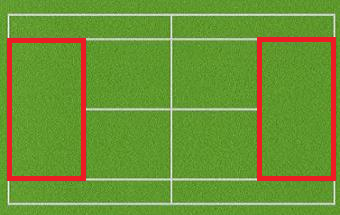

Backspin
A shot that causes the ball to rotate backwards after it is hit, causing it to bounce at a lower angle. Also known as a slice or underspin.
Backswing
When the racquet is swung back in preparation for the forward swing.
Ball Toss
Prior to a serve, the ball is tossed upwards. This is what’s known as a ball toss.
Baseline
A line on either end of the court; this line determines the boundaries of play.

Baseline game
Refers to a player that often stays at the baseline to hit their shots. The opposite would be net game.
Block
A shot with not much backswing, which is meant as a defensive shot. Often used for powerful shots like serves.
Bounce
The movement the ball makes after hitting the ground. A ball’s bounce can be influenced by things such as court surface, weather, spin, or power of the shot.
Bumper Guard
A plastic protector on the upper-half of a tennis racquet.
C
Call
When a line judge or chair umpire declares that a ball is ‘out’.
Center Line
A line extending from the middle of the net to the middle of the service line; used to divide both sides of the services boxes.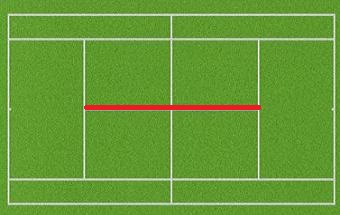

Center Mark
A line that marks the middle of the baseline; used for determining the correct side to serve.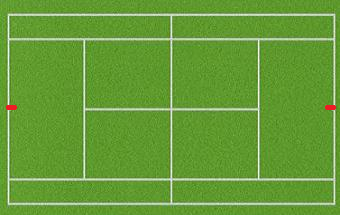

Changeover
For every odd-numbered game, players change sides (after both sides have had the chance to serve).
Chip
A block shot with underspin.
Chop
A shot with extreme underspin.
Closed Stance
Court
A standard tennis court is typically made up of clay, grass, or concrete and its measurements are 78 feet long and 36 feet wide. For singles matches, the court is 27 feet wide while for doubles, the entire width of the court is used. The net stand 3 feet and 6 inches tall at the posts while at the center, the net is 3 feet tall.
Cross-court
Hitting a shot diagonally across the tennis court.
D
Defensive Lob
A defensive lob is used in order for the player to get time to recover or to get back in position.
Deuce
A score of 40-40 in a game. If a deuce is reached, a player(s) must win 2 points in a row in order to win the game.
Deuce Court
The right side of the court, where players serve first at the beginning of a game and also when a deuce is reached.
Disadvantage
When a player(s) is 40-advantage down.
Double Court
The court used exclusively for doubles matches. The entire width and length of the court is used.
Double Fault
Two serving faults in a row, causing the serving player to lose the point.
Doubles
A match where both sides consists of two players, also resulting in the the use of the full court.
Doubles Sideline
The furthest sidelines of a court, which measures 36 feet apart.

Down the line
A ball that is hit straight along the sideline of the tennis court.
Draw
The schedule of matches in a tennis tournament. The starting matches are determined by a process of seeding and random selection. A qualifying competition also determines which participant will compete in the main draw.
Drop Shot
A very light shot designed to barely go over the net, often with backspin.
E
Elbow
The corner of the baseline and the alley.
Error
A shot that does not land in the opposing player’s court, causing the loss of a point.
F
Face
The flat area of a tennis racquet made up of strings.
Fault
A serve that does not land in the opponent’s service box. A second fault is known as a double fault.
First Serve
A player has two attempts at a serve. The first serve is coincidentally known as the “first serve”.
Follow Through
The rest of a swing after the ball has been hit.
Foot Fault
During a serve, a player cannot step on or over the baseline into the court before a serve is completed. A player also may not step across the center mark. Doing so results in a foot fault and the serve is lost.
Forecourt
The area between the service line and the net.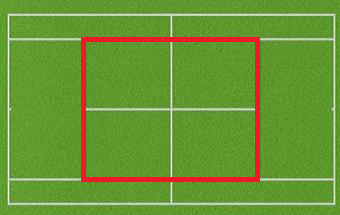

Forehand
A groundstroke that is hit with the front of the racquet; a right-handed player hits a forehand on the right side of the court and vice versa.
Frame
The oval part of the racquet that bounds the tennis strings together; also known as an unstrung racquet.
G
Game
A game is made up of a sequence of points where the same player serves throughout. The scoring system goes from 0-15-30-40-game. A set consists of six games.
Grip
The way in which a tennis racquet is held, which changes throughout a match in order to accommodate the shots a player is making. The most recognizable grips are the Western Grip, the Eastern Grip, the Continental Grip, the Semi-Western Grip, the Australian Grip, and the Hawaiian Grip.
Groundstroke
Hitting the ball after it bounces once with either a forehand or backhand. Groundstrokes are primarily used for balls that land within the backcourt.
H
Half Court
Also known as mid-court or no-man’s land. Refer to mid-court.
Head
The part of the racquet that includes the frame and strings.
I
Inside-in
Running around the backhand side to hit a forehand down the line. The same goes for an inside-in backhand.
Inside-out
Running around the backhand side to hit a forehand cross-court. The same goes for an inside-out backhand.
J
Jam
To hit a ball toward an opponent’s body, causing them to move more to return it, often resulting in a weak return.
K
Kick Serve
A serve where the ball has a lot of spin, causing it to either change direction or bounce high. Also known as the American twist and introduced in the late 1880s.
Kill
To hit a ball hard enough that the opponent can’t reach it.
L
Lawn Tennis
Refers to modern “regular tennis”, which derived from “real tennis“. Lawn tennis is referred to this name because the game was first played on grass.
Let
Also known as a do-over, commonly used for serves. A serve where the balls hits the net cord and falls within the receiver’s service box is given a let-serve, or another attempt. A ball that hits the net cord but lands outside of the play area counts as a serve attempt. A let can also be called for distractions that are not caused by the players themselves.
Lob
A shot that is hit high above the net. A defensive lob is used in order for the player to get time to recover or to get in position. An offensive lob is used to hit the ball above an opposing player at net.
Lob volley
A type of volley shot that is used to hit the ball above an opposing player at net.
Love
A term used in tennis to indicate zero. For example, a score of 30-0 is called 30-love.
Love game
A game where the loser scores no points.
Love set
A set where the loser wins no games.
M
Match
An official term for two players/teams who play against each other. A match often consists of either three or five sets.
Match Point
When a player needs one more point to win the match.
Mid-court
Also known as half-court, or no-man’s land. Most tennis players hit their shots into mid-court, so an opposing player standing in mid-court will have a hard time returning them. Recommended that you do not stay in mid-court for more than one shot (weak serve, etc.).
Mis-hit
A stroke where the racquet fails to hit the “sweetspot”, or center, of the strings.
Mixed Doubles
A doubles match where teams consist of one male and one female.
N
Net
A standard net is made up of interlaced fabric, tape, and cord spanning the entire width of the court. It is held up by the posts, which stands 3 feet and 6 inches from the ground, while at the center the net stands 3 feet tall.
Net Cord
The cord that supports the net.
Net Game
Refers to a tennis player that takes every opportunity to attack the net. The opposite would be baseline game.
Net Posts
Posts that stand on either side of the court, typically 3 feet 6 inches high and placed 3 feet outside of the tennis court.
Neutral Stance
A stance where the hitter’s back foot is parallel with the baseline while the front foot lies at a diagonal angle, sometimes up to 90 degrees. Also known as the standard or square stance.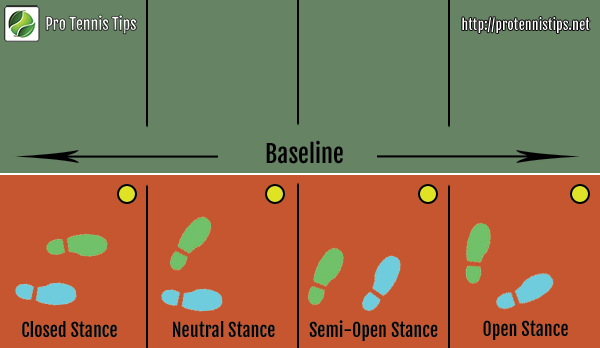

No-man's Land
O
Offensive Lob
A lob that is typically used against a player at net, in the hopes that the ball will be too high for the opposing player to return.
Open Stance
Any stance where the hitter’s back foot is closer to the ball than the front foot and they are not parallel.

Out
Any ball lthat lands outside the playing area is considered an “out”.
Overhead Shot
Any shot that is hit above the player’s head but is not a smash.
Overhead Smash
A shot that is hit above the player’s head with great force.
P
Pass
Also known as a passing shot, a pass is a type of shot that passes an opposing player at net on either side but not above them.
Poach
In doubles matches, the player at net that hits a ball intended for their partner is “poaching”.
Point
A point is the smallest unit of scoring in tennis. A game is won by scoring 4 points with at least a 2 point difference from the opposing player.
Pulp
A score of 30-30.
Punch Volley
A type of short volley that consists of a “punching” stroke.
Putaway
An offensive shot intended to end the point with no hope of a return.
Q
Qualies
Qualifying competition of a tournament used to determine who will enter the main draw.
Qualifier
A player who has won the pre-tournament qualifying competition and enters the tournament’s main draw.
R
Racquet
Also known as a racket, it is a bat with a long handle and oval frame consisting of strings meshed together. A typical racquet’s frame is made out of either wood, metal, graphite, composite, or synthetic material. A racquet is used by a player to hit the tennis ball.
Rally
After a ball is served, the ensuing series of hits is known as the rally. A rally ends when one of the players fails to return the ball or hits the ball outside of the play area.
Rankings
A listing used to determine qualification of a player into a tournament based on entry or seeding.
Rating
A listing used by national tennis organizations to rate players’ skills into comparable groups.
Real Tennis
An indoor racquet sport which eventually led to the game of modern day tennis, or “lawn tennis” Real tennis is also known as court tennis in the US and royal tennis in AU. Refer to Real Tennis.
Receiver
The player who receives the ball from the opposing player.
Return
To hit a ball back to the opposing player.
Return Ace
A shot where the opponent serves, the receiver returns the shot, and the opponent does not hit the ball.
S
Scoring
The scoring system consists of points, games, and sets in order to track progress.
Second Serve
A player serving has two attempts to hit a serve within the receiver’s service box. The second and final attempt is called a second serve.
Seed
When a player is entered into a tournament based on his/her ranking so as to avoid playing other ranked players early on. Depending on the size of the draw, the number of seeds can vary. For example, ATP tournaments typically have 1 out of 4 players as seeds while for a 32 player International Series tournament, approximately 8 players will be seeds.
Semi-open Stance
A stance where both of the hitter’s feet lie parallel to each other, with the back foot closer to the ball than the front foot. Halfway between an open stance and neutral stance.

Serve
The starting stroke of a point. A player must serve throughout the entire game and has two attempts per point to serve the ball diagonally into the receiver’s half of the service box. A typical serve consists of a ball toss and a cross-court overhead shot (although underhand is allowed), and must be performed on either side of the center mark without crossing into the court or the other half.
Server
The person who serves throughout an entire game. Players take turns serving every game.
Service Box
Square area of the forecourt, where a serve must land in to count.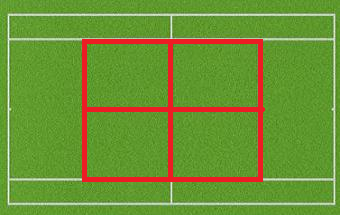

Service Line
A line that runs parallel to the net and determines part of the service box area.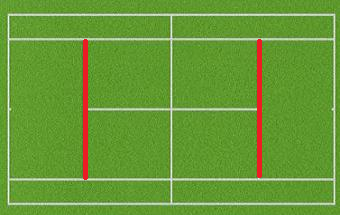

Service Sideline
The lines on either side of the singles court that determines part of the service box area.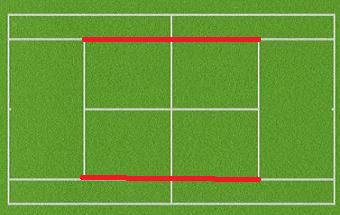

Set
A set consists of 6 games; a player that win 6 games with at least a two-game advantage wins the set.
Shot
The act of hitting the ball with the racket.
Sideline
The line on either side of the court that determines the side boundary. The doubles sideline is the furthest sideline and measures 36 feet apart while the inner sideline measures 27 feet apart.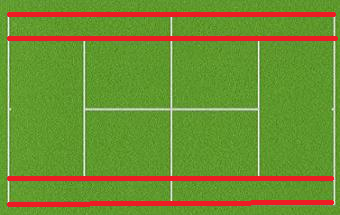

Singles
A match between two players against each other.
Singles Court
The court used exclusively for singles matches. The inner sideline is used, which measures 27 feet apart.
Singles Sideline
The inner sideline which measures 27 feet apart.

Slice
A type of shot with underspin.
Smash
An overhead with great force, also known as an overhead smash, often performed while at net.
Spin
Rotation of the ball as it moves through the air, affecting its bounce and trajectory.
Stance
The way in which a player stands when hitting the ball.
Strings
The material that is meshed together to form the face of the racquet. The strings are primarily what comes into contact with the ball.
Stroke
The act of hitting the ball with the racket.
Sweetspot
The center of the racquet head, which is the best location for hitting a ball.
T
T
Refers to the section of the court where the center line meets the service line to form a T.

Tape
The material that covers the top of the net.
Tennis Ball
A rubber ball filled with air and coated with a fur that is often made of synthetic materials. The measurements of an official tennis ball is 2.57 to 2.70 inches in diameter and weighs 56.0 to 59.4 grams. The only accepted colors in tennis tournaments is yellow and white.
Tennis Elbow
Refers to an injury that beginner to intermediate tennis players get, due to improper technique or a racquet that causes too much vibration to the arm. People that don’t play tennis can still get tennis elbow due to overuse of the arm, forearm, and hand muscles.
Tension
Refers to how tight the strings are.
Topspin
Spin where the top of the tennis ball rotates toward the direction of travel, causing it to dip and bounce at a higher angle.
Toss
The winner of a coin toss chooses who serves first. The toss is also performed by spinning the racket and guessing whether the logo on the hilt will be up or down.
Touch
Touching any part of the net while the ball is in play results in the loss of the point.
Two-handed Backhand
Backhand shot where both of the player’s hands are on the handle.
U
Underhand Serve
A serve where the player’s racquet is below shoulder level. This serve is often used by beginners.
Underspin
Also known as backspin, where the ball is hit so that the top rotates away from the direction of travel, causing a ball that floats and bounces at a lower angle.
Unforced Error
An error resulting from the player’s poor judgement or performance that was not caused by external influences.
V
Vantage
Another word for advantage, or when a player has won 1 point out of 2 in a deuce.
Volley
A shot that is hit within the forecourt before the ball bounces on their own side.
W
Wide
A way of saying that the ball has landed out of bounds beyond the sideline.
Winner
Also known as a kill or putaway where the opponent cannot reach the ball.
X
Y
Z
That’s all the tennis terms we have to share with you, but if you are still interested in reading more, you can visit this page to learn more about the basics of tennis.
